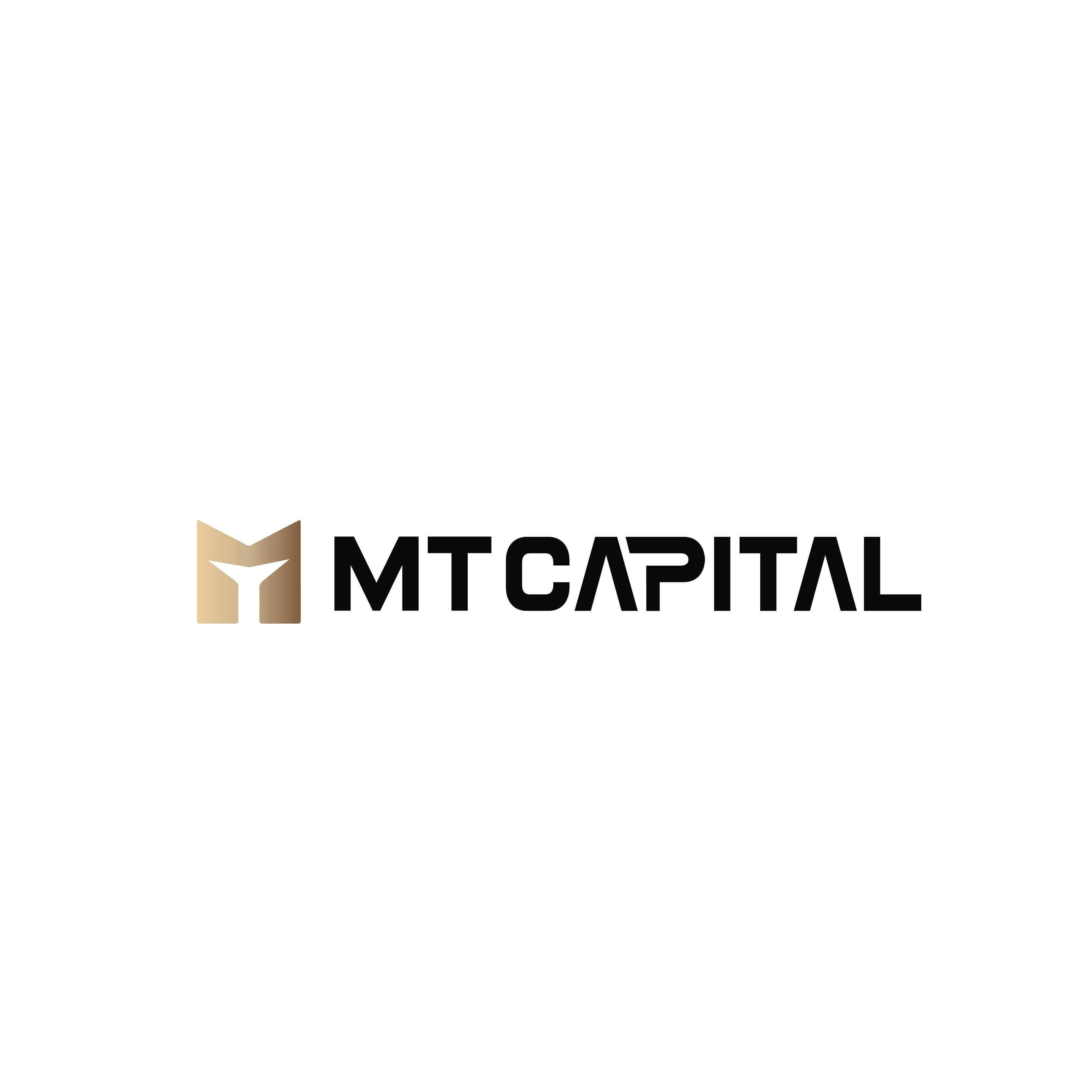Original author: Xinwei, Ian
TLDR
We believe that the development of the AI x Crypto track is sustainable and not just a temporary craze. As AI technology develops and time passes, we expect to see more funding and attention continue to flow into this area, leading to multiple rounds of development opportunities. Therefore, laying out the AI x Crypto track is not only feasible, but also a necessary strategic choice.
In the field of AI x Crypto, we can see multiple subdivisions, including AI Agent, decentralized computing, data, oracles, ZKML, FHEML, coprocessors, Meme, universal basic income, generative art platform and Games and other applications. In these fields, decentralized computing is particularly eye-catching. Whether it is GPU computing or algorithm models, they represent a huge space for innovation, and the demand for computing power is extremely high. Computing power has become a form of consensus, and its value potential It is comparable to the market value ceiling of public chains. At the same time, we are also optimistic about ZKML, FHEML and co-processors, which are still in early stages but have huge potential.
Taking into account the current market liquidity, project fundamentals and community influence, Worldcoin, Arkham, Render Network, Arweave, Akash Network, Bittensor and io.net are all major projects that we believe have leadership and development potential.
introduction
In the past few years, the AI x Crypto field has experienced unprecedented development and change. This emerging field combines two of the most transformative technologies: blockchain and artificial intelligence to explore how decentralized approaches can empower AI applications to increase transparency, security and user control. With the rapid advancement of artificial intelligence technology, especially the rise of generative artificial intelligence, and the growing demand for decentralized solutions, AI x Crypto has become one of the most exciting innovation frontiers in technology.
A new landscape of assetization in the AI x Crypto field: the road to innovation in computing power, models and data
The most direct use case of Crypto is assetization, and in the field of AI x Crypto,"Assetization of computing power"、"Model/Agent assetization",and"Data capitalization"There are three major scenes.
In the capitalization of computing power, there are two main directions: decentralized computing and decentralized reasoning of AI Agents. Decentralized computing focuses on using distributed networks to train AI models. AI Agent mainly uses trained AI models to perform decentralized reasoning. These AI Agents can be deployed in decentralized networks to provide users with various intelligent services, such as automated transactions, knowledge assistants, or security audits.
However, from a technical perspective, the current training of large AI models involves massive data processing and high-speed communication bandwidth requirements, which places extremely high demands on hardware facilities. Currently, training large Transformer models usually requires the configuration of high-end CPUs such as NVIDIAs H 100 or A 100, NVIDIAs NVLink technology to connect GPUs, and professional fiber switches to achieve network connections above 100 Gbps to support training across multiple data centers. These models contain billions to tens of billions of parameters and require powerful computing power and video memory to execute deep network algorithms. At the same time, in order to quickly supply data for processing, high-speed storage and network bandwidth are necessary to reduce I/O bottlenecks. Parallel computing strategies such as model parallelism and data parallelism require high-speed internal and external network bandwidth to achieve efficient synchronization among multiple GPUs. These requirements indeed make decentralized AI training extremely challenging under current technology and cost conditions.
The AI inference performed by AI Agent has lower requirements for computing power and communication bandwidth, making the decentralized approach more feasible and practical. This is also the reason why many computing power-related projects currently on the market focus more on inference rather than training. Nonetheless, centralized solutions often still outperform decentralized solutions at this stage when considering cost-effectiveness and reliability.
The assetization of models/Agents is also an important direction, especially driven by large language models such as GPT, which has become an important trend. Users can interact with AI-based virtual characters. Converting these AI Agents into NFTs allows users to buy, sell, collect or exchange, similar to art trading. However, projects in this direction often have low technical thresholds, insufficient innovation, and a low degree of integration of AI and Crypto. Many projects only convert AI models into NFTs without thinking deeply about the combination of AI and Crypto, which will lead to homogeneous competition in the market. In addition, Agents are basically stored on cloud servers, and only the ownership certificate is made into NFT and placed on the chain, and the degree of integration with Crypto is shallow.
Data capitalization is also an important direction of the AI x Crypto track, focusing on using decentralized technology and incentive mechanisms to release and utilize large amounts of data resources that are usually limited to private domains, including personal data and internal corporate data. Once these data are converted into resources that can be used to train or Fine-Tune large models, they can significantly improve the professionalism and efficiency of AI models in different vertical fields. However, factors such as data diversity, quality, application scenarios, and privacy protection increase the complexity of data assetization, making standardization a challenge. Although it is possible to NFT data that cannot be standardized, it also highlights the difficulty of establishing a highly liquid and easy-to-trade market.
As a part of data capitalization, decentralized data annotation is implemented through Label to Earn"Patterns, or crowdsourcing platforms, improve data availability and quality while reducing cost and time by motivating community members to participate in data annotation. This method of decentralizing labor not only ensures the efficiency and quality of data annotation, but also ensures that participants receive fair rewards, providing a new path for data assetization.
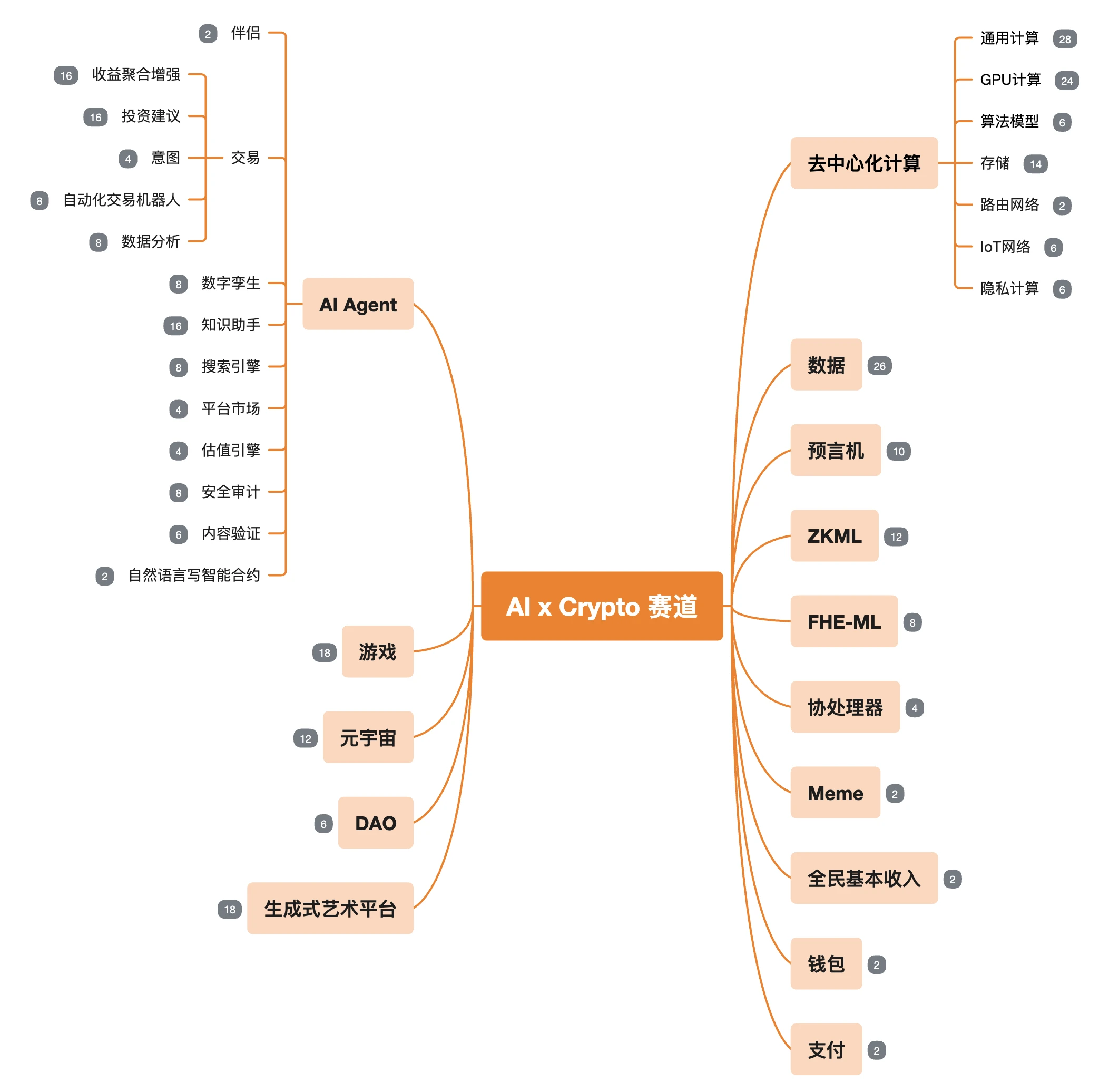
Source: MT Capital
As can be seen from the above, the current scenarios for the actual establishment of the AI x Crypto track are relatively limited, and the threshold in most directions is low. The recent market enthusiasm is mainly due to capital operations and emotional FOMO. The AI x Crypto track currently has several core pain points:
Immature business model: AI x Crypto is currently in a very early stage, and many projects that try to combine the two are not mature enough and fail to give full play to their respective advantages. As teams with a deep understanding of both areas step in, it is expected that more solutions will be developed that both demonstrate the power of AI technology and deeply integrate Crypto features.
The dual challenge of interdisciplinary expertise and practitioner preference: In AI x Crypto projects, teams often have either a deep background in the field of AI or a deep understanding of Web3 and cryptocurrency, but it is difficult to balance both. This not only limits the ability to innovate in technology and explore business models, but also reflects the preference of practitioners when choosing fields, that is, excellent AI talents are often reluctant to get involved in the encryption industry. This lack of interdisciplinary expertise, in conflict with practitioner preferences, has become a major obstacle to promoting innovation in this field. In the future, teams that can work across boundaries and have insights into both AI and encryption technologies will become a key force for innovation and progress in this field.
Technical challenges of internal empowerment: When Crypto tries to empower AI from within, such as through ZKML and FHEML, the main pain point faced is the poor scalability of these technologies, which makes them encounter limitations in practical applications. Likewise, when AI attempts to power Crypto from within, there will need to be solved not only the complex engineering issues of how to integrate AI into existing systems, but also ensuring that this integration works effectively and does not hinder system performance. These two challenges together reflect the need for not only innovative technical solutions when deeply integrating AI and Crypto, but also the need to overcome complexity and scalability issues in implementing these solutions.
Despite the current difficulties, we still believe that AI x Crypto is one of the most important tracks in this cycle. The combination of AI and Crypto not only shows strong technical potential and application prospects, but also occupies a unique and important position in the current technology and investment fields:
1. AI’s status in the technological revolution: AI is widely considered to be the key force driving the next round of technological revolution. Compared with the previous round of concepts with the Metaverse as the core, it requires more practical applications and there are challenges in user data verification. Especially with the stock prices of Metaverse concept companies like Roblox and Meta plummeting, the popularity of the Metaverse is quickly fading. And unlisted high-tech companies like OpenAI dont need to prove their value through revenue at this stage. Compared with the Yuanverse, AI has a wider influence in practical applications and technological innovation. It has penetrated into many fields such as medical care, education, transportation, and security, and has the ability to promote the improvement of the entire high-tech industry chain. Decentralized computing power further unleashes the potential of AI, providing necessary computing resources through distributed networks to support the training and reasoning of AI models, promoting the progress and widespread application of AI technology.
2. The importance of computing power: In the AI x Crypto project, the importance of computing power is self-evident. Computing power is not only directly related to the efficiency and effectiveness of AI model training, but is also an important indicator to measure the technical strength of the project and market consensus. The higher the computing power, the stronger the consensus and the higher the market value. As more companies and individuals participate in decentralized computing power contributions, not only can the optimal allocation of resources be achieved, but also the exploration of new economic models and value distribution methods can be promoted, such as through computing power mining and AI computing power hosting. etc.
Representative project
Worldcoin
The reason why WLD has performed so well recently is simple. On February 15, OpenAI released Sora, a large video generation model. Through text commands, Sora is able to generate high-definition videos of up to 60 seconds that contain highly realistic backgrounds, complex multi-angle shots, and emotionally charged multi-character narratives that demonstrate a deep understanding of real-world physics. Although people are looking forward to the release of GPT-5, the impact brought by Sora is comparable to that of a GPT-5 release.
This incident has reignited enthusiasm for the field of AI. As everyone knows, Sam Altman, the founder of Worldcoin, is also the CEO of OpenAI. Under the operation of bookmakers, WLD quickly became the brightest focus in the market at the beginning of the year.
Worldcoin mainly involves two areas: identity authentication and issuance of digital currency. OpenAI is rumored to be developing two types of agent robots that are capable of deeply understanding human instructions and acting on them, in what is seen as the final step toward artificial general intelligence (AGI). After reaching this point, almost all jobs may be replaced, and the vast majority of people will face unemployment, but they cannot starve to death. At this time, OpenAI needs to issue basic income (UBI) through Worldcoin, and you can receive 6 WLD every month just through iris recognition.
However, a detailed analysis will reveal that WLD has no substantial empowerment and exists more as a hyped air currency. If WLD is really used to issue basic income in the future, this form of non-stable currency may cause various problems. This is why Worldcoin’s white paper and founders are ambiguous when discussing the role of WLD.
WLD will probably always be a meme coin. Still, that doesnt mean WLD doesnt have investment value. WLD has similarities to DOGE in terms of market capitalization. If Altmans fame can surpass Musks, WLD may have a chance to reach the market value of DOGE. However, its high unit price limits its potential as a top meme coin to a certain extent. If the price of Worldcoin is more affordable, it will undoubtedly greatly increase its appeal as a top meme coin. As a top figure in the AI field, every relevant public statement or major event in the AI field by Sam Altman will have a significant impact on the Worldcoin market, increasing the attractiveness and uncertainty of Worldcoin as an investment target.
If there is a split-coin operation in the future, that is, redefining Worldcoins market positioning with a lower unit price and higher circulation, such a strategy may trigger a rapid increase in price.
Although there is currently a certain ambiguity in Worldcoins market positioning and practical applications, making it regarded as a meme coin by some, Altmans influence and the rapid development of the AI field have provided Worldcoin with unique market momentum. If reasonable market strategies are adopted in the future, such as currency splitting, Worldcoin has the potential to become a force that cannot be ignored in the market.
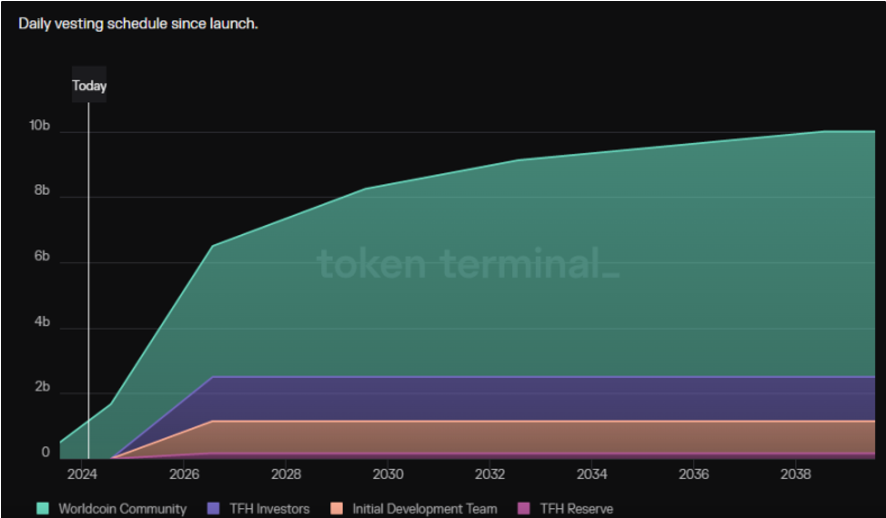
Source: https://foresightnews.pro/article/detail/53744
Arkham
Founded in 2020 and headquartered in the United States, Arkham is led by founder and CEO Miguel Morel, with a team that includes head of operations Zachary Lerangis, head of BD Alexander Lerangis and institutional relations expert John Kottlowski. Arkham has raised more than $12 million in funding, including a $2.5 million public round from Binance Labs. The founders are veterans of the crypto industry, having previously founded Reserve, a stablecoin project designed for high-inflationary economies, with investors including Peter Thiel, Sam Altman, Coinbase, and Digital Currency Group, among others.
Binance announced on July 10, 2023 that Arkham’s token $ARKM will be listed on its Launchpad. This is the first time Binance has launched a tool product, which has aroused great interest.
Arkham is a platform that uses artificial intelligence algorithms to analyze blockchain data. It can associate blockchain addresses with real-world entities, providing users with a complete view of the behavior behind them. Arkham recently launched a blockchain intelligence trading platform called Arkham Intel Exchange, which allows users to request required information through bounties, and information providers can receive rewards for providing information. Arkham also offers powerful tools that allow users to search, filter and sort any crypto trade, revealing the entities and individuals behind market activity.
In addition to being listed on Binance, multiple exchanges such as Kraken, OKX, and Hotbit also support $ARKM trading.
Arkham has launched a model called “Intel-to-Earn” that enables an intelligence economy by matching buyers and sellers on the blockchain. Its platform token $ARKM is used to pay for analytics platform fees, governance voting, and user incentives. The total supply of $ARKM is 1 billion, the listed circulation is 150 million (15% of the total supply), and the test website has 200,000 registered users. After being listed on the exchange, the trading volume is expected to reach US$100 million.
Arkham mainly consists of two major components: blockchain analysis tools and intelligence trading market. The analysis tools provide users with comprehensive data insights through entity pages, token pages, network mapping, etc. Arkham uses its self-developed artificial intelligence engine Ultra to de-anonymize blockchain data and algorithmically match addresses with real-world entities. The intelligence trading market allows users to buy and sell information through bounties, auctions, and data sharing. Arkham maintains the long-term operation of the platform by charging a fee - a 2.5% manufacturing fee on payments for listings and auctions, and a 5% acceptance fee on bounty payments and successful auctions.
Compared with other data analysis platforms on the market, Arkham has several unique advantages, such as creating token usage scenarios, realizing on-chain data value transactions through intelligence exchanges, and providing data analysts with a channel to monetize knowledge; through commissions Other means to achieve self-motivation of the platform are conducive to the sustainable development of the platform; provide archiving functions for users to track historical investment portfolios; and visualize data maps to reduce research costs. However, Arkham also faces some challenges, such as a small number of public chain supports, a functional gap with platforms such as Nansen, limited replicability of token scenarios, a user group dominated by professionals, and limited appeal to ordinary investors. , and its own data processing capabilities are weak, relying on external data teams, etc.
The Arkham project has first-mover advantages and broad market space in the field of blockchain information analysis, but it is still in its early stages. The business model needs to be verified, and ecological construction and scale-up will take time to cultivate. In terms of risks, the popularization of on-chain information analysis takes time, user education costs are high, the replicability of the business model is limited, users are mainly professionals and rely on personnel for information processing, operating costs are high and risks are high, and the quality of information is uneven. There are reputational risks, as well as uncertainty about regulatory policy changes.
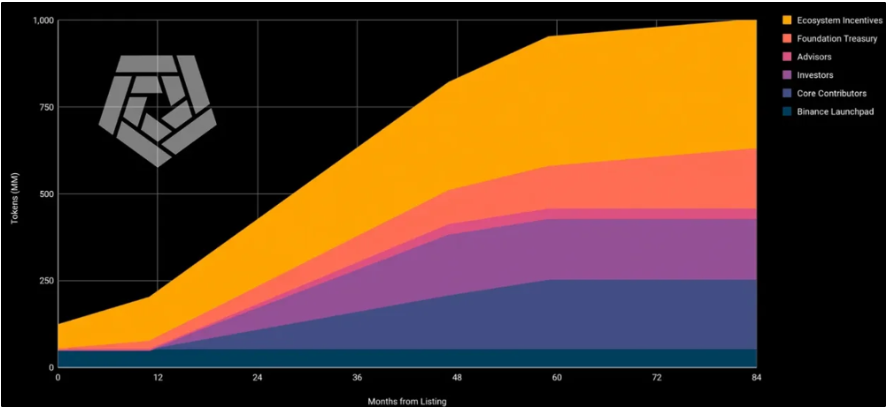
https://foresightnews.pro/article/detail/48222
Render Network
Render Network, since its launch in April 2020, has become a leading decentralized rendering platform, bridging users in need of GPU computing power with providers with spare computing resources. This platform mainly serves high-demand computing fields such as artificial intelligence, virtual reality and multimedia content creation. Through its unique dynamic pricing strategy, it takes into account the complexity, urgency and available resources of the task to provide all parties with a fair solution. and a competitive market environment. This way, GPU owners can plug their devices into the Render Network and leverage OTOY-developed OctaneRender software to accept and complete rendering tasks. In exchange, users pay RNDR tokens to individuals who complete rendering tasks, and OTOY takes a small portion of RNDR as a fee to facilitate transactions and network operations.
Render Network is based in the United States and was founded by Jules Urbach. Urbach is not only the founder of Render Network, but also the founder and CEO of OTOY. He has profound insights and contributions to the development of 3D rendering technology and decentralized computing platforms.
Render Network has completed several rounds of funding, including strategic financing. On December 21, 2021, Render Network successfully raised US$30 million in a round of strategic financing. Investors in this round of financing include Multicoin Capital, Alameda Research, Sfermion, Solana Ventures, Vinny Lingham and Bill Lee and other well-known investment institutions and personal. In addition, Render Network also raised US$1.16 million in funds through ICO in January 2018. The successful raising of these funds not only provided support for Render Networks technology development and market expansion, but also reflected the markets potential for decentralized rendering services. recognition.
Render Network leverages the peer-to-peer networking capabilities of the RNDR token to effectively distribute workloads among idle GPU resource providers while encouraging nodes to share their untapped computing power through an incentive mechanism. This move not only maximizes resource utilization efficiency, but also creates value for participants and promotes the prosperity of the decentralized rendering ecosystem.
In December 2023, Render achieved a major technological leap and migrated its infrastructure from Ethereum to Solana. This transition brought new capabilities to Render, including real-time streaming, dynamic NFT, and state compression, significantly improving the network performance and scalability, while opening up richer and more diverse application scenarios for users.
DePIN (Decentralized Physical Infrastructure Network), as a brand new concept, consists of two main areas: digital resource network and physical resource network. It aims to encourage individuals to participate in real-world infrastructure through the physical proof of work (PoPW) mechanism. construction and efficient utilization. The emergence of DePIN not only brings innovative solutions to the traditional information and communication technology (ICT) industry, but also heralds the arrival of a more decentralized and efficient infrastructure network model.
Although the current ICT industry faces challenges such as high thresholds and inefficient resource utilization, DePIN has introduced a peer-to-peer network-based model to reuse idle resources, while at the same time lowering the threshold for participation and enhancing market competition through disintermediation. power and efficiency.
The successful upgrade of Render Network and its tight integration with Solana demonstrate the advantages of the decentralized rendering platform in responding to real-time responses and reducing transaction costs. This not only strengthens Renders leadership position in the DePIN field, but also strengthens its future prospects. Development opens up new paths.
As Render Network continues to advance technological innovation and ecosystem construction, its potential in multiple frontier areas such as decentralized rendering, artificial intelligence, and digital rights management is gradually emerging. Render is not only a rendering service platform, but also a powerful engine that drives innovation, connects resources and needs, and promotes decentralization and digital transformation. With the continuous advancement of technology and the growth of market demand, Render Network is expected to become one of the key forces driving new developments in the digital economy.
Source: https://dune.com/lviswang/render-network-dollarrndr-mterics
Arweave
Arweave is an innovative decentralized data storage protocol designed to enable permanent storage of data. Through its unique permaweb, Arweave makes stored data accessible in human-readable form (e.g., via a web browser), creating a durable, immutable Internet. This permanent storage capability is revolutionary for ensuring the immutability and permanent accessibility of information, especially in application scenarios that require a high degree of data integrity and durability, such as legal document storage and academic research archiving. and areas such as copyright protection.
Arweave incentivizes data storage providers in the network through its native token AR. This economic incentive mechanism ensures the sustainability of the network and the expansion of storage capabilities. As an infrastructure and storage network project, Arweave aims to reinvent the way data is stored and accessed. Formerly known as Archain, it was founded in 2017 and is headquartered in Germany. Arweave’s founding team includes co-founders and CEOs Sam Williams and COO Sebastian Campos Groth, as well as head of legal Giti Said. They have extensive experience in the technical, operational and legal fields and are a key force in driving the development of the Arweave project.
Since its mainnet launch in June 2018, Arweave has attracted widespread attention and received support from several important investors, including well-known a16z Crypto, Coinbase Ventures and Union Square Ventures. A public funding round in May 2018 raised $1.57 million. Since then, the project has conducted two rounds of financing in November 2019 and March 2020, raising US$5 million and US$8.3 million respectively, with investors including a16z Crypto, Multicoin Capital, Union Square Ventures, and Coinbase Ventures.
The AO solution launched by Arweave represents a major innovation in blockchain technology, mainly reflected in the hyper-parallel computer architecture it provides. This architecture allows any number of processes to be run in parallel at the same time in a decentralized computing environment, greatly improving computing efficiency and scalability. The core features of AO include large-scale computing capabilities, the implementation of verifiable calculations, and the highly parallel processing capabilities and reliability achieved by building three different sub-networks (messenger unit, scheduling unit, computing unit) and using Arweave as the base layer. Scalability.
Named AO (Actor Oriented), it is inspired by the Actor model in computer science. This model is particularly suitable for designing and implementing highly concurrent, distributed, and fault-tolerant systems. Through AO, the Arweave team demonstrated its deep understanding and innovative solutions for the future development of the decentralized computing environment.
Source: https://foresightnews.pro/article/detail/54511
AO is built on the base layer of Arweave, using Arweaves on-chain storage as a permanent host for its running data, which strengthens its decentralized computing capabilities and allows any number of parallel processes to run at the same time, achieving a similar data center How to collaborate with computers on the Internet. In addition, a key part of AO is AOS, a specific operating system based on the AO architecture that allows developers to develop applications using the Lua language, further enhancing its ease of use and flexibility.
The launch of AO aligns with Arweave’s long-term goal of supporting a highly scalable blockchain network through its data storage platform. Although the Arweave team encountered challenges in achieving this goal, their persistence and innovation ultimately made AO possible. This not only enhances the functionality of the Arweave chain, enabling it to support more smart contracts and blockchain protocols, but also provides a new and powerful solution for decentralized computing.
Arweave AO works beyond the limitations of traditional blockchain technology, enabling unprecedented horizontal scalability by breaking down the three main parts of the blockchain into independent components that can communicate with each other and execute large numbers of transactions simultaneously. This innovation not only opens up new possibilities for Arweaves own development, but also provides new perspectives and inspiration for the entire blockchain and decentralized technology fields.
Ultimately, Arweaves goal is to make AO a stable system that only requires low-frequency updates, similar to Bitcoin, ensuring the continuity of core functions and user rights. This stability and transparency is very important to users as it allows them to have a deeper trust and understanding of the protocols they use. As Arweave AO continues to develop and improve, it has the potential to become an important participant in the decentralized smart contract platform, forming strong competition with existing blockchain technologies such as Ethereum.
Akash Network
The core value of Akash Network lies in its role as a decentralized computing platform that utilizes the worlds underutilized GPU resources and connects these resources with users who need GPU computing power. This platform not only provides profit opportunities for owners of GPU resources, but also provides more cost-effective options for users who need these resources. According to data from September 2023, Akash Network has successfully deployed 150 to 200 GPUs on its network and achieved utilization rates of 50% to 70%. This achievement is reflected in the total annual transaction value of US$500,000 to US$1 million, demonstrating the market potential of the decentralized computing resource sharing model.
Further analysis of Akash Networks business model shows that the analogy with Airbnb in the real estate market is quite apt. Akash creates a marketplace where owners of GPU resources can rent out their unused computing power like Airbnb hosts, and users who need these resources can obtain the computing power they need at a lower cost. This model not only increases the utilization of GPU resources, but also lowers the threshold for entering the fields of artificial intelligence and machine learning.
With the rapid development of artificial intelligence, the demand for high-performance computing resources such as GPUs has increased dramatically. Nvidia, the leader in GPU manufacturing, expects its revenue to grow significantly in a few years, from $27 billion in 2022 to $60 billion in 2023, and is expected to reach about $100 billion by 2025. This growth forecast reflects the strong global demand for GPU computing power and also provides Akash Network with a broad market space.
Akash Networks decentralized model is particularly suitable for the current market environment, where the demand for cloud computing services is increasing day by day, and the vast amount of GPU computing power around the world is not fully utilized. Through Akash, the supply side can provide idle GPU resources, while the demand side can obtain the necessary computing power at a lower cost. This model not only optimizes the allocation of resources, but also promotes the democratization of computing power, allowing more enterprises and individuals to participate in the research and development of artificial intelligence and high-performance computing.
The native token of Akash Network is AKT, which plays several important roles in the network. First, AKT is used to pay for computing resources on the network, including but not limited to GPU computing, storage, bandwidth, etc. Secondly, AKT is also part of network governance, and holders can participate in the network decision-making process through token voting, such as protocol updates and improvement proposals. In addition, AKT also serves as an incentive mechanism to encourage users to participate in network maintenance, including providing computing resources, verifying transactions, etc.
In order to encourage more users to provide unused computing resources, Akash designed an incentive mechanism, which is mainly implemented in two ways: token rewards and transaction fees.
Token rewards: The Akash network provides rewards to users who provide computing resources through the issuance of new tokens. These newly issued tokens are distributed to resource providers as incentives to encourage them to connect more resources to the Akash network. In addition, network validators and users participating in network governance can also receive AKT token rewards to motivate them to participate in the security and governance of the network.
Transaction Fees: The Akash network charges fees for transactions using its services, which are paid in AKT tokens. According to Akashs policy, part of the transaction fees are allocated to nodes that provide computing resources as a direct economic incentive for them to provide services.
Akash charges a 4% fee for transactions paid in AKT and a higher 20% fee for transactions paid in USDC, a stablecoin. This differentiated fee structure is designed to promote the circulation and use of AKT tokens, while also providing financial support for the maintenance and development of the network.
Akash Network has also set up a community pool that collects a portion of the network’s revenue, including tokens generated by inflation and transaction fees. Funds from the community pool are used to fund projects and proposals for network development, such as technical improvements, marketing activities, etc. The community votes to determine the allocation of funds.
Through this complex but effective token model and incentive mechanism, Akash Network not only ensures the active and healthy development of the network, but also provides users with the opportunity to participate in and benefit from the network. These incentives help attract more resource providers and users to join the Akash ecosystem, promoting the long-term success and continued growth of the decentralized computing platform.
However, despite the promising market prospects of Akash Network, the challenges it faces cannot be ignored. In addition to competing with traditional cloud service providers, Akash must constantly optimize its technology platform to ensure efficient and secure services. In addition, building and maintaining a decentralized market also requires constantly attracting new resource providers and users and maintaining a high degree of market activity.
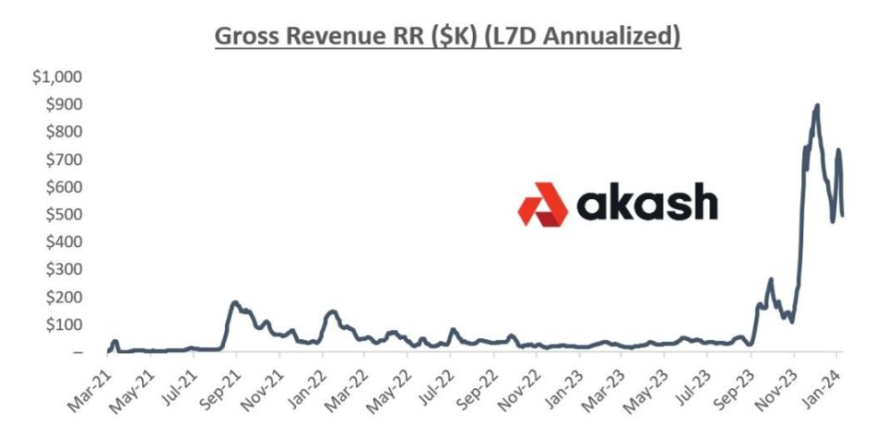
Source: https://www.modularcapital.xyz/writing/akash
Bittensor
Bittensor was founded in 2019 by AI researchers Ala Shaabana and Jacob Steeves and was originally conceived as a parachain for Polkadot. In March 2023, the project changed its strategy and decided to develop its own blockchain, aiming to incentivize global machine learning nodes through cryptocurrency and promote the decentralization of AI development. By letting these nodes train and learn collaboratively with each other, Bittensor introduces a new paradigm that enhances the collective intelligence of the network by integrating incremental resources, expanding the contribution of individual researchers and models to the whole.
Bittensor introduces multiple innovative concepts and mechanisms, such as distributed expert model (MoE) and proof of intelligence (Proof Of intelligence), aiming to promote the development of a decentralized AI ecosystem by rewarding useful machine learning models and results. Its token economics design and ecosystem structure are designed to support and reward network participants, incentivizing fair distribution practices and network participation through TAO tokens.
Bittensor’s architectural design reflects its pursuit of building a robust AI ecosystem. Through the layered structure of miner layer, validator layer, enterprise layer and consumer layer, Bittensor aims to build a network that fully supports AI innovation. Among them, the AI model of the miner layer drives innovation, the verifier layer maintains the security and integrity of the network, and the enterprise layer and consumer layer ensure that technological achievements can be transformed into practical applications to meet the needs of the market and society.
The core participants of the Bittensor network include miners and validators. Miners submit pretrained models in exchange for rewards, while validators are responsible for confirming the validity of model outputs. Bittensor creates a positive feedback loop through an incentive mechanism, encouraging competition among miners and promoting model refinement and performance improvement.
Although Bittensor itself is not directly involved in training the model, its network provides a platform that allows miners to upload and fine-tune their own models. This approach allows Bittensor to integrate multiple models and handle different tasks through specific sub-networks, such as text generation and image generation.
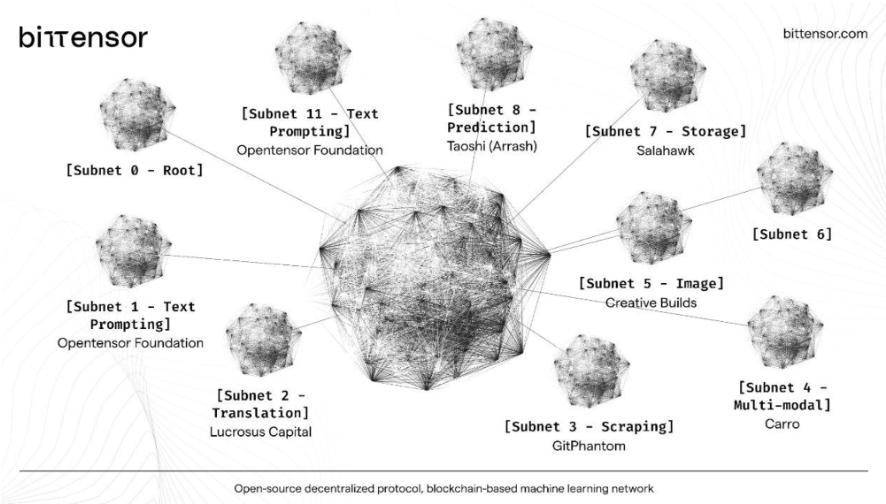
Source: https://futureproofmarketer.com/blog/what-is-bittensor-tao
The sub-network model adopted by Bittensor is a major feature of its architecture. These sub-networks focus on the execution of specific tasks. In this way, Bittensor attempts to achieve composite and decentralized intelligence of models, although this goal still faces challenges within the limitations of current technology and theory.
Bittensors token economic model is deeply influenced by Bitcoin and adopts a similar token issuance mechanism and incentive structure. TAO tokens are not only part of the network rewards, but also the key to access Bittensor network services. The long-term goal of the project is to promote the democratization of artificial intelligence technology and promote model iteration and learning in intelligent networks through a decentralized approach.
Compared with traditional centralized AI models, Bittensors biggest advantage is that it promotes the openness and sharing of AI technology, allowing AI models and algorithms to be iterated and optimized in a wider community, accelerating technological progress. In addition, Bittensor is expected to reduce the application cost of AI technology through its decentralized network structure, allowing more individuals and small businesses to participate in AI innovation.
io.net
io.netIt is an innovative decentralized GPU network designed to solve the problem of computing resource acquisition in the field of machine learning (ML). The project creates a massive pool of computing power by integrating GPU resources from independent data centers, cryptocurrency miners, and those involved in projects like Filecoin and Render. Founder Ahmad Shadid came up with this idea when he faced high costs and resource acquisition problems while building a GPU computing network for the machine learning quantitative trading company Dark Tick in 2020. Subsequently, at the Austin Solana Hacker House, the project gained wider attention and recognition.
io.netThe main challenge is to address the limited availability, lack of choice, and high cost of computing resources. By aggregating underutilized GPU resources,io.netProvides a distributed solution that enables machine learning teams to build and scale their model serving workflows across a decentralized network. In this process, it uses advanced distributed computing libraries, such as RAY, to support parallel processing of data and models, thereby optimizing the task scheduling and hyperparameter adjustment process.
In terms of products,io.netA range of tools and services are provided, including IO Cloud, IO Worker and IO Explorer. IO Cloud is designed to deploy and manage decentralized GPU clusters, achieving seamless integration with IO-SDK and providing a comprehensive solution for scaling AI and Python applications. IO Worker provides a comprehensive user interface that enables users to effectively manage their computing resource provisioning operations, including features such as account management, real-time data display, and temperature and power consumption tracking. IO Explorer provides comprehensive visualization of network activities and important statistics, helping users better monitor and understand network status.
To incentivize participation and balance demand and supply,io.netIntroducing IO tokens, whose functions include rewarding continued use by AI and ML deployment teams, pricing IO Worker compute units, and participating in community governance. Additionally, given the price volatility of cryptocurrencies,io.netThe stablecoin IOSD, which is pegged to the US dollar, has also been specially developed to stabilize the payment system and incentive mechanism.
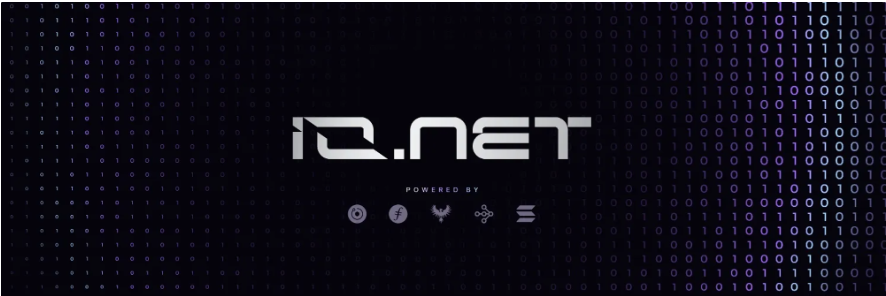
Source: https://io.net/
io.net shows strong innovation capabilities and market potential in both technology and business models. Through its cooperation with Filecoin, it is expected to further expand its capabilities in model storage and computing resources, providing strong support for the development and expansion of decentralized AI applications. At the same time, by providing a cost-effective, easy-to-access and use platform, io.net aims to become a strong competitor to traditional cloud computing service providers such as AWS and promote innovation and progress in the entire AI field.
On the capital side, io.net has successfully completed a Series A round of funding, raising $30 million at a valuation of $1 billion. This round of financing attracted the participation of many well-known investment institutions including Hack VC, Multicoin Capital, Delphi Digital, Animoca Brands, Solana Ventures, Aptos, OKX Ventures, Amber Group, etc. This series of investments reflects the market’s high recognition of io.net’s innovative capabilities and market potential in the fields of decentralized computing and artificial intelligence.
Summarize
With the continuous advancement of AI and blockchain technology, the AI x Crypto field shows great potential and opportunities, and also faces a series of challenges. In-depth analysis"Assetization of computing power"、"Model/Agent assetization"as well as"Data capitalization"From these three core scenarios, we can see the innovation paths and existing obstacles in this field. Decentralized computing power opens up new possibilities for AI training and inference, although the dependence on high-performance computing resources and communication bandwidth needs to be addressed. The assetization of models and agents provides proof of ownership through NFT and improves the interactive experience, but technology integration still needs to be deepened. Data capitalization unlocks the potential of private domain data. Facing the challenges of data standardization and market liquidity, it also opens up new avenues for AI efficiency and specialization.
It is worth noting that as AI technology continues to develop and iterate, it will periodically attract hot spots and funds to flow into the AI x Crypto field, bringing a continuous wave of development to AI rather than a single stage of opportunity. The enduring value and innovation potential of the AI x Crypto field marks it as a key track in the technology and investment fields.
Looking to the future, the development of AI x Crypto will rely on technological innovation, interdisciplinary cooperation and the exploration of market needs. By breaking through technical limitations, deepening the integration of AI and blockchain, and developing practical application scenarios, this field is moving towards long-term development and providing more secure, transparent and fair AI services. In this process, decentralized concepts and technical practices will continue to promote the development of the AI x Crypto field in a more open, efficient and innovative direction, ultimately achieving a double leap in technological innovation and value creation. Therefore, the AI x Crypto track in the current cycle is an important opportunity that cannot be missed. It not only represents the forefront of technological innovation, but also heralds important trends in future technological progress and investment direction.
References
MT Capital
MT Capital is a global investment institution managed by a team of experienced investors. It focuses on investing in innovative Web3 projects around the world, with its layout covering the United States, Hong Kong, Dubai and Singapore. Our main investment areas include: 1) Mass Adoption: decentralized social platforms, games, applications and DEPIN, which are key to driving the diffusion of Web3 technology to a broad user base; 2) Crypto-native infrastructure: we focus on Invest in public chains, protocols and other infrastructure that support and strengthen the ecosystem, as well as native DeFi solutions. In addition, our team has many years of professional experience in secondary transactions.
Official website:https://mt.capital/
Twitter:https://twitter.com/mtcap_crypto

